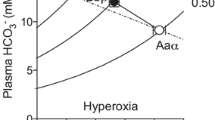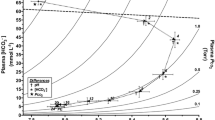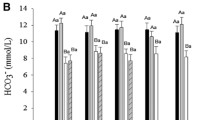Abstract
CO2 exposure elicits multiple changes in the acid–base balance and hematology of avian embryos, but the time-specific, dose-dependent effects of graded increases in extrinsic CO2 in a normoxic environment are poorly understood. Consequently, we exposed day 15 chicken embryos to 1, 3, 5, 6 or 10 % CO2 in 20 % O2. We hypothesized that both the magnitude of hypercapnic respiratory acidosis and the resultant metabolic compensation within 24 h of exposure to <10 % CO2 are proportional to ambient CO2 concentration ([CO2]). We also predicted that regulation of hematological respiratory variables is graded according to [CO2]. Time-course (2, 6 and 24 h) changes were determined for acid–base disturbances and hematological respiratory variables; hematocrit (Hct), red blood cell concentration ([RBC]), hemoglobin concentration, mean corpuscular volume (MCV) and other mean corpuscular indices. Both the decrease in uncompensated pH, which indicates uncompensated respiratory acidosis, and the compensatory pH increase, a sign of metabolic compensation, increased with [CO2]. The partial metabolic compensation across all CO2 gas mixtures was ~17, 46 and 53 % compensation at 2, 6 and 24 h, respectively. Hematological responses were nearly identical across the entire range of [CO2], with Hct decreasing across the time course of CO2 exposure due to a decrease in MCV from 2 to 24 h and a decrease in [RBC] at 24 h. Even though hematological regulation was not graded, chicken embryos were able to compensate and survive exposure to <10 % CO2.




Similar content being viewed by others
Abbreviations
- Hct:
-
Hematocrit
- [RBC]:
-
Red blood cell concentration
- MCV:
-
Mean corpuscular volume
- [Hb]:
-
Hemoglobin concentration
- MCH:
-
Mean corpuscular hemoglobin
- [MCHb]:
-
Mean corpuscular hemoglobin concentration
- [CO2]:
-
Carbon dioxide concentration
- [O2]:
-
Oxygen concentration
- PaCO2 :
-
Arterialized blood carbon dioxide partial pressure
- pHa :
-
Arterialized blood pH
- [HCO3 −]a :
-
Arterialized blood bicarbonate concentration
- Osm:
-
Blood osmolality
- ΔpH:
-
Change in pH
- Δ[HCO3 −]:
-
Change in blood bicarbonate concentration
- ΔHct:
-
Percent change in hematocrit
- Δ[RBC]:
-
Percent change in red blood cell concentration
- ΔMCV:
-
Percent change in mean corpuscular volume
References
Andrewartha SJ, Tazawa H, Burggren WW (2011) Hematocrit and blood osmolality in developing chicken embryos (Gallus gallus): in vivo and in vitro regulation. Respir Physiol Neurobiol 179:142–150
Bissonnette JM, Metcalfe J (1978) Gas exchange of the fertile hen’s egg: components of resistance. Respir Physiol 34:209–218
Boggs DF, Birchard GF, Kilgore DL Jr (1983) Blood characteristics, tracheal volume and heart mass of burrowing owls (Athene cunicularia) and bobwhite (Colinus virginianus). Comp Biochem Physiol 74A:693–696
Bruggeman V, Witters A, De Smit L, Debonne M, Everaert N, Kamer B, Onagbesan OM, Degraeve P, Decuypere E (2007) Acid–base balance in chicken embryos (Gallus domesticus) incubated under high CO2 concentrations during the first 10 days of incubation. Respir Physiol Neurobiol 159:147–154
Burggren WW, Andrewartha SJ, Tazawa H (2012) Interactions of acid–base balance and hematocrit regulation during environmental respiratory gas challenges in developing chicken embryos (Gallus gallus). Respir Physiol Neurobiol 183:135–148
Dawes CM, Simkiss K (1971) The effects of respiratory acidosis in the chick embryo. J Exp Biol 55:77–84
Everaert N, De Smit L, Debonne M, Witters A, Kamers B, Decuypere E, Bruggeman V (2008) Changes in acid–base balance and related physiological responses as a result of external hypercapnia during the second half of incubation in the chicken embryo. Poult Sci 87:362–367
Everaert N, Willemsen H, Kamers B, Decuypere E, Bruggeman V (2011a) Regulatory capacities of a broiler and layer strain exposed to high CO2 levels during the second half of incubation. Comp Biochem Physiol A 158:215–220
Everaert N, Willemsen H, Willlems E, Franssens L, Decuypere E (2011b) Acid–base regulation during embryonic development in amniotes, with particular reference to birds. Respir Physiol Neurobiol 178:118–128
Mueller CA, Tazawa H, Burggren WW (2013) Dynamics of metabolic compensation and hematological changes in chicken (Gallus gallus) embryos exposed to hypercapnia with varying oxygen. Respir Physiol Neurobiol 185:272–280
Mueller CA, Burggren WW, Tazawa (2014) The physiology of the avian embryo. In: Scanes CG (ed) Sturkie’s Avian physiology, 6th edn. Elsevier, San Diego (In press)
Piiper J, Tazawa H, Ar A, Rahn H (1980) Analysis of chorioallantoic gas exchange in the chick embryo. Respir Physiol 39:273–284
Severinghaus JW, Stupfel M, Bradley AF (1956a) Accuracy of blood pH and PCO2 determination. J Appl Physiol 9:189–196
Severinghaus JW, Stupfel M, Bradley AF (1956b) Variations of serum carbonic acid pK’ with pH and temperature. J Appl Physiol 9:197–200
Tazawa H (1980) Oxygen and CO2 exchange and acid–base regulation in the avian embryo. Amer Zool 20:395–404
Tazawa H (1981a) Compensation of diffusive respiratory disturbances of the acid–base balance in the chick embryo. Comp Biochem Physiol 69A:333–336
Tazawa H (1981b) Effect of O2 and CO2 in N2, He, and SF6 on chick embryo blood pressure and heart rate. J Appl Physiol Respir Environ Exerc Physiol 51:1017–1022
Tazawa H (1982) Regulatory processes of metabolic and respiratory acid–base disturbances in embryos. J Appl Physiol Respir Environ Exerc Physiol 53:1449–1454
Tazawa H (1986) Acid–base equilibrium in birds and eggs. In: Heisler N (ed) Acid–base regulation in animals. Elsevier, Amsterdam, pp 203–233
Tazawa H, Mikami T, Yoshimoto C (1971) Effect of reducing the shell area on the respiratory properties of chicken embryonic blood. Respir Physiol 13:352–360
Tazawa H, Piiper J, Ar A, Rahn H (1981) Changes in acid–base balance of chick embryos exposed to a He or SF6 atmosphere. J Appl Physiol Respir Environ Exerc Physiol 50:819–823
Tazawa H, Visschedijk AHJ, Piiper J (1983) Blood gases and acid–base status in chicken embryos with naturally varying egg shell conductance. Respir Physiol 54:137–144
Tazawa H, Andrewartha SJ, Burggren WW (2011) Development of hematological respiratory variables in late chicken embryos: the relative importance of incubation time and embryo mass. Comp Biochem Physiol A 159:225–233
Tazawa H, Andrewartha SJ, Burggren WW (2012) Acute regulation of hematocrit and blood acid–base balance during severe hypoxic challenges in late chicken embryos (Gallus gallus). Respir Physiol Neurobiol 184:86–96
Visschedijk AHJ, Tazawa H, Piiper J (1985) Variability of shell conductance and gas exchange of chicken eggs. Respir Physiol 59:339–345
White FN, Bartholomew GA, Kinney JL (1978) Physiological and ecological correlates of tunnel nesting in the European bee-eater, Merops apiaster. Physiol Zool 51:140–154
Wickler SJ, Marsh RL (1981) Effects of nestling age and burrow depth on CO2 and O2 concentrations in the burrows of bank swallows (Riparia riparia). Physiol Zool 54:132–136
Acknowledgments
Support for this study was provided by NSF operating Grant IOS-1025823 to Warren W. Burggren.
Author information
Authors and Affiliations
Corresponding author
Additional information
Communicated by G. Heldmaier.
Rights and permissions
About this article
Cite this article
Mueller, C., Tazawa, H. & Burggren, W. Dynamics of acid–base metabolic compensation and hematological regulation interactions in response to CO2 challenges in embryos of the chicken (Gallus gallus). J Comp Physiol B 184, 641–649 (2014). https://doi.org/10.1007/s00360-014-0822-3
Received:
Revised:
Accepted:
Published:
Issue Date:
DOI: https://doi.org/10.1007/s00360-014-0822-3




